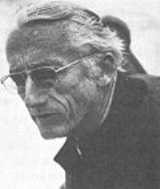
, ecologist, filmmaker, innovator, scientist, photographer, author and researcher who studied the sea and all forms of life in water. He co-developed the aqua-lung
, pioneered marine conservation and was a member of the Académie française
.
He was also known as "le Commandant Cousteau" or "Captain Cousteau".
Cousteau was born on 11 June 1910, in Saint-André-de-Cubzac
, Gironde, France to Daniel and Élisabeth Cousteau.
From birth, man carries the weight of gravity on his shoulders. He is bolted to earth. But man has only to sink beneath the surface and he is free.![]()
Buoyed by water, he can fly in any direction — up, down, sideways — by merely flipping his hand. Under water, man becomes an archangel.![]()
The sea is the universal sewer.![]()
We must plant the sea and herd its animals … using the sea as farmers instead of hunters. That is what civilization is all about — farming replacing hunting.![]()
Farming as we do it is hunting, and in the sea we act like barbarians.![]()
If we go on the way we have, the fault is our greed — if we are not willing — we will disappear from the face of the globe, to be replaced by the insect.![]()
What is a scientist after all? It is a curious man looking through a keyhole, the keyhole of nature, trying to know what’s going on.![]()
Man, of all the animals, is probably the only one to regard himself as a great delicacy.![]()
I am not a scientist. I am, rather, an impresario of scientists.![]()
I said that the oceans were sick but they're not going to die. There is no death possible in the oceans — there will always be life — but they're getting sicker every year.![]()

